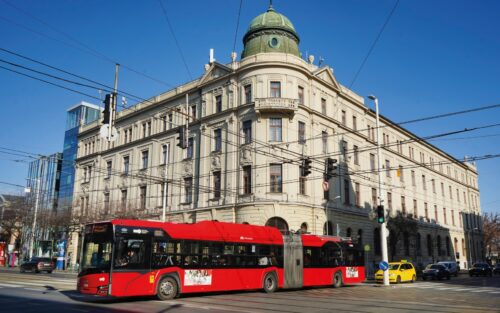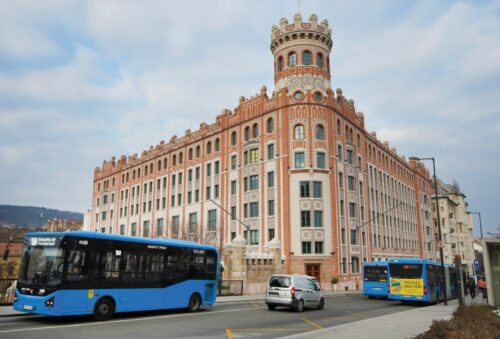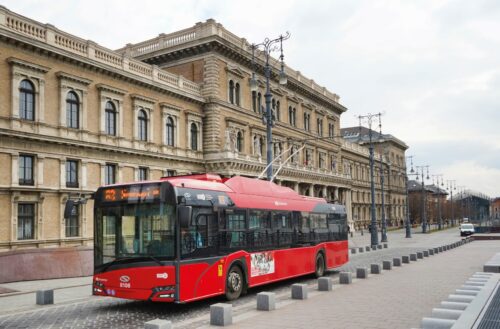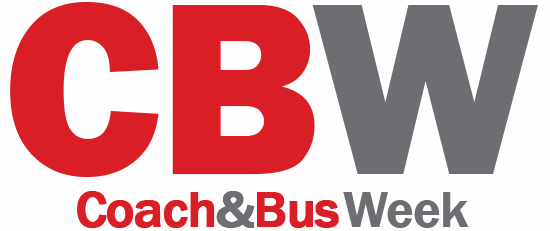
Andrew Thompson takes us to Budapest, where the two halves of the city share a transport network with buses in two colours
As one of the celebrated cities of Central Europe, the Hungarian capital Budapest has an extensive public transport network that includes metro, tramway, a historic funicular and even a rack railway. The vast bus system complements the other modes of transit and acts as an aggregator, particularly serving those outlying neighbourhoods without rail links. Formed in 1873 through a merger of the previously separate cities of Buda and Pest, each district occupies one bank of the River Danube. As such Pest on the east side is noteworthy, as it also features an extensive trolleybus network, which first opened in 1933 and currently has a size of about 78km.
Most of the radial trolleybus lines were built after the Second World War and developed from 1949 onwards. The trolley network is anchored on Keleti railway station and intersects with the tramway or metro at numerous interchange points. The trolleybus lines all have numbers in the 70s and 80s, with the major trunk lines being 72, 76 and 78. Since 2017 line 72 has run in auxiliary battery mode through the historic city centre on the stretch between Arany János utca and Kálvin tér, where overhead power lines have not been installed. This flexible operation and simple range extension was made possible by a fleet of 16 articulated, low-floor Trollino 18 buses which were delivered by the Polish producer Solaris in 2015.

That same year Solaris also supplied 20 shorter, 12m rigid Trollino 12s. Due to the success and reliability of this modern trolley fleet, an additional 50 articulated Trollino 18s were delivered between 2019 and 2023, plus 22 more Trollino 12 during the same four-year span.
While the Solaris fleet now forms the backbone of all trolleybus services in Budapest, some of the older Ikarus–Kiepe and Ganz–Škoda-Solaris buses from the early 2000s also remain in regular service. Even the last high-floor Ikarus–GVM type 280T high-floor trolleys of late 1980s vintage still remain in use as reserve vehicles and can be seen on lines 77, 80 and 81. Despite their lack of low-floor access, they are comfortable vehicles with excellent visibility through the large window panes. Locally beloved as icons of 20th century Hungarian bus building, numerous Ikarus buses are already preserved in Budapest and used for active heritage purposes. As of February 2025, the active trolleybus fleet for all revenue services included 173 vehicles.
Blue and red
Unlike in other European cities, where public transport typically has one traditional livery, in the Hungarian capital all modes of transport have their own colour code. This means that while trams are yellow, trolleybuses are red and regular buses blue.
From the blue fleet of diesel or battery-electric buses, the most important services are lines 100E and 200E to the airport. Indeed, Budapest is one of those continental cities without a high capacity rail link to the airport, thus placing greater importance on the relevant bus links. While line 100E connects the airport with the main city centre square Deák Ferenc tér and runs 24/7 with a peak hour headway of 6-10 minutes, line 200E shuttles on the shorter route between the airport and the Kőbánya-Kispest terminus of metro line M3.

Not surprisingly, the newest MAN Lion’s City articulated buses are deployed on line 100E, which is operated by Arriva under contract to the municipal transport company BKK. Line 100E costs a special supplement and is overwhelmingly used by international visitors. All public transport is free in Budapest and Hungary for everyone over 65 years of age, including tourists.
In late 2024, Arriva won an additional 12-year contract from BKK to operate 82 electric buses supplied by Chinese producer BYD. Services with the 58 new rigid and 24 articulated e-buses will start in 2026, with options for a further 21 vehicles.
Shorter, eight metre long midibuses from the Turkish builder Karsan or electric shuttles of the eight metre long Ikarus Modulo Medio type are a common sight, especially on the hilly west bank of the Danube in Buda, where they serve the castle district or also pass over the iconic Chain Bridge from 1849. Probably Hungary’s most famous landmark, this 375m long span is actually a larger variant of the historic chain bridge over the River Thames at Marlow. Correspondingly, Budapest’s Chain Bridge was designed by the same English engineer, William Tierney Clark (1783-1852), who then entrusted local construction supervision in Hungary to the Scotsman Adam Clark (1811-1866). After a nine-year build, the bridge opened in 1849.

